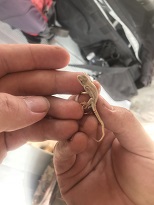Dunes Sagebrush Lizard (Sceloporus arenicolus)
Description: The dunes sagebrush lizard is a small, light brown phrynosomatid lizard (family Phrynosomatidae, genus Sceloporus) with a maximum snout-to-vent length of 2.8 inches for females and 2.6 inches for males
Habitat: Their habitat is restricted to semi-stabilized sand dunes which include large networks of shinnery oak (Quercus havardii), short shrubs, and sand sagebrush (Artemisia filifolia) on sloping, sandy topography, where the lizards use "blowouts" as their primary microhabitat. Blowouts are sandy, bowl-shaped interruptions in the shinnery oak sand dune system which look like small meteor craters. The roots of the shinnery oak shrubs provide structure for the dunes sagebrush lizards' burrows, where the lizards retreat from the blowouts when the sand surface is too hot or cold.
Range: Only occurs in the shinnery oak sand dune systems of extreme southeast New Mexico and only four counties in adjacent Texas. Sceloporus arenicolus has the second-smallest range of all lizards in the United States.
Found in these States:
NM |
TX
Diet: Eats ants and ant pupae, small beetle adults and larvae, crickets, grasshoppers, and spiders; feeds mainly in or near patches of vegetation.
Reproduction: Individual females lay 1-2 clutches of 3-6 eggs; first clutches are laid in late June, second clutches from late July to early August; hatchlings appear from late July to late September; females may attain sexual maturity during the first spring following hatching; apparently at least some individuals reach at least two years of age.
Status: Listed as Vulnerable because its area of occupancy is probably less than 2,000 kmē, its distribution is severely fragmented, and there is continuing decline in its area of occupancy, in the extent and quality of its habitat, in the number of locations, and in the number of mature individuals.
»» Kingdom: Animalia - Animals
»» Phylum: Chordata - Chordates
»» Subphylum: Vertebrata - Vertebrates
»» Class: Reptilia - Reptiles
»» Order: Squamata - Lizards
»» Family: Phrynosomatidae - North American Spiny Lizards
»» Genus: Sceloporus
»» Species: Sceloporus arenicolus - Dunes Sagebrush Lizard
»» Subspecies: None
This article uses material from the Wikipedia article "Sceloporus arenicolus", which is released under the Creative Commons Attribution-Share-Alike License 3.0. Content may have been omitted from the original, but no content has been changed or extended.
|








